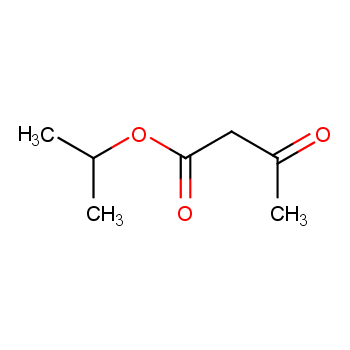Basic Information
Isopropyl acetoacetate, also known as 3-butanone isopropyl acetoacetate or acetoacetic acid isopropyl ester, has the CAS number 542-08-5. Its molecular formula is C7H12O3 and molecular weight is 144.168. It is a colorless and transparent oily liquid with an aromatic odor. Isopropyl acetoacetate is mainly used in the synthesis of pharmaceuticals and pesticides, and it has a broad market prospect. It is soluble in ethanol, chloroform, ether, and toluene, among other organic solvents.

Background Technology
Isopropyl acetoacetate is an important intermediate in pharmaceuticals and pesticides. In the field of pharmaceuticals, it is mainly used as an intermediate for cardiovascular drug nimodipine and the synthesis of 2-(3-nitrobenzyl) isopropyl acetoacetate. It is also a basic raw material for the synthesis of organophosphorus insecticide fenitrothion.
The existing technologies mainly include the following routes:
1) Synthesis by ester exchange: using ethyl acetoacetate or methyl acetoacetate as raw materials, the ester exchange reaction is carried out with isopropanol under reflux conditions to obtain the final product, isopropyl acetoacetate. This process has a long reaction time and low yield, with a maximum yield of 87%. It also involves the recovery of solvent toluene, which results in high costs.
2) Claisen ester condensation route: this route requires expensive metallic sodium, and the synthesis yield is low. There is no mature industrial report on this route.
3) Synthesis by reflux reaction of diethyl ketone and isopropanol under acid catalysis: this method has a maximum yield of 86.5%. However, due to the presence of acid, the reaction produces isopropyl ether byproduct, which greatly affects the reaction yield. Therefore, repeated distillation is usually required during the purification process, resulting in a large amount of product decomposition and ultimately leading to low yield.
All of the above processes either have expensive raw materials or low yields, resulting in high production costs.
Synthesis Method
In a 500ml flask equipped with a stirrer, thermometer, and reflux condenser, add 150g (2.5mol) of isopropanol and 0.36g of triethylamine. At room temperature, slowly add 210g (2.5mol) of diethyl ketone. Control the reaction temperature at 70℃ and maintain it for 6 hours after the addition is complete. After the reaction is completed, the crude ester is subjected to vacuum distillation to obtain the final product, isopropyl acetoacetate, with a yield of 95.2% and a purity of 99.3%.
References
[1] Shandong Huihai Pharmaceutical Chemical Co., Ltd. A method for preparing isopropyl acetoacetate: CN201711336217.X[P]. 2018-05-04.
[2] Nantong Acetic Acid Chemical Co., Ltd. A preparation process for isopropyl acetoacetate: CN201711055780.X[P]. 2018-03-27.




